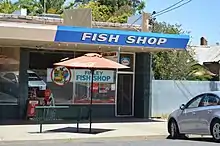Fish and chip shop
A fish and chip shop, sometimes referred to as a chip shop or chippy, is a restaurant that specialises in selling fish and chips. Usually, fish and chip shops provide takeaway service, although some have seating facilities. Fish and chip shops may also sell other foods, including variations on their core offering such as battered sausage and burgers, to regional cuisine such as Greek or Indian food.[1]



Variations on the name include fish bar, fishery (in Yorkshire), fish shop and chip shop. In most of the United Kingdom including Northern Ireland, they are colloquially known as a chippy or fishy, while in the Republic of Ireland and the Aberdeen area, they are known as chippers.
History
A blue plaque at Oldham's Tommyfield Market in England marks the 1860s origin of the fish and chip shop and fast food industries. In 1928, Harry Ramsden's fast food restaurant chain opened in the UK. On a single day in 1952, his fish and chip shop in Guiseley, West Yorkshire, served 10,000 portions of fish and chips, earning itself a place in the Guinness Book Of Records.
Etymology
The word "chip shop" is first recorded by the Oxford English Dictionary in 1892.[2] "Chippy" or "chippie" was first recorded in 1961.[3] Occasionally the type of fish will be specified, as in 'Cod-n-Chips'.
Operations
Many British villages, suburbs, towns and cities have fish and chip shops, especially near coastal regions.
Fish and chip outlets sell roughly 30% of all the white fish consumed in the United Kingdom, and they use 10% of the UK potato crop.[4]
In Ireland, many "chippers" are operated by Italian immigrant families, all native to the Province of Frosinone in Lazio.[5] The Italian chip shop tradition began with Giuseppe Cervi, who took a boat to America in the 1880s but instead disembarked at Queenstown (modern-day Cobh in County Cork) and walked to Dublin, establishing a takeaway at 22 Great Brunswick Street (modern-day Pearse Street).[6][7][8]
Regional differences
.jpg.webp)
In Scotland, the fish tends to be haddock, whereas in England, it tends to be cod. This is because both fish tend to be sourced from Scottish waters in the North Sea and then shipped around the UK. Haddock was thought to taste better than cod when fresh, while cod tasted better a few days later. In the days before refrigerated haulage this meant that haddock would taste bad by the time it made it out of Scotland, while the cod would still taste good if it took a few days to reach its destination.[9] Hake, pollock, whiting, and plaice are also seen at many chip shops.[10] In Scotland, 'special fish' is a variant where the haddock is breadcrumbed instead of battered.
A number of fish and chip shop condiments exist, including salt and vinegar (very often actually non-brewed condiment) across the UK, mushy peas and curry sauce in various parts of the UK, chip spice in Hull,[11] Hendersons Relish in Sheffield, chippy sauce in Edinburgh,[12] gravy across much of the UK, mushy pea and mint sauce in Nottingham, and gravy and cheese in Yorkshire. In Canada, most shops offer malt vinegar or the option to add gravy, usually for a small charge.
There are also regional variations with the oil used to cook the fish and chips. Traditional frying uses beef dripping or lard, which are still used in the Midlands and the North; however, vegetable oils, such as palm oil, rapeseed or peanut oil (used because of its relatively high smoke point) now predominate, particularly in the South.
There are also a number of other offerings at fish and chip shops that do not involve fish, such as the battered sausage. It is now generally rare to find a fish and chip shop that offers no main course besides fish and chips in the UK. Burgers, pies, pasties, pizzas, sausages, kebabs and chicken (all of which may or may not be served or bought with chips) are all regular menu items in many outlets. Many also offer chips with topping options such as cheese, mushy peas, gravy or curry sauce.
In Australia, a common variant of the fish and chip shop is one that sells charcoal chicken in addition to the usual battered fish and related foods.
There are also regional variations across the UK, including:
- Pastie in Northern Ireland
- Potato scallops in the West Midlands (a deep-fried slice of potato)
- Deep fried Mars bars in Scotland
- Red pudding in Fife, Scotland
- Pukka Pies in England
- Saveloy in London
- Faggots in Coventry and the Black Country
- Batter bits in Leeds and the North
- Battered roe in the West Midlands
- Orange Chips or Battered Chips in the Black Country[13]
- Pizza Crunch in Glasgow
- Pickled onion in the West Midlands and other parts of the UK
- Battered white pudding in Scotland and Northern Ireland
- Deep fried haggis as a supper across Scotland. As "Haggis Balls" in Glasgow or "Haggis Bon-Bons" in Edinburgh.
- Pea fritters[14]
- Yorkshire Fishcake[14]
- Rag pudding in Oldham
- Butter pie in Lancashire
- Doner kebab in the Midlands and other parts of the UK
- Scampi in various parts of the UK
- Chip butty in various parts of the UK
- Steak and kidney pie in various parts of the UK
- Babies 'Yed in the North West of England
- Light-fried half chicken in the Midlands and other parts of the UK
- Spam fritters in various parts of the UK
- Rock in Cornwall and the south
- Lemon sole in Cornwall and the south
- Rissoles in South Wales
- Wigan Kebab (meat and potato pie in a buttered barm) in Wigan
- Pasty barm in Bolton
There are also variations in the fish and chip shops in nations and former nations of the British Commonwealth:
- "Hamburger With The Lot" in Australia and a "Works Burger" New Zealand
- Poutine in Canada
- Dim sims in Australia and New Zealand
- Chiko Rolls in Australia
- Spice Burger in Ireland
- Hot sandwiches (usually chicken or turkey with peas and gravy) in Canada
References
- Tsirtsakis, Anastasia (22 September 2019). "Old school fish and chips in Moonee Ponds, the Greek way". NEOS KOSMOS. Retrieved 16 February 2022.
- "chip, n.2". Archived from the original on 26 January 2022. Retrieved 2 April 2014.
- "chippy, n.". Archived from the original on 24 September 2015. Retrieved 2 April 2014.
- "As British as Fish And Chips". Archived from the original on 18 December 2012. Retrieved 17 March 2017.
- "The History of ITICA — ITICA". www.itica.ie. Archived from the original on 14 June 2019. Retrieved 1 June 2019.
- "A postcard, Giuseppe Cervi and the story of the Dublin chipper". 14 March 2017. Archived from the original on 1 June 2019. Retrieved 1 June 2019.
- "How fish and chips enriched a nation". The Irish Times. Archived from the original on 9 December 2018. Retrieved 1 June 2019.
- "6 interesting facts from the unique history of Irish-Italian chippers". TheJournal.ie. 21 October 2016. Archived from the original on 1 June 2019. Retrieved 1 June 2019.
- Sherwood, Harriet (18 August 2019). "Where did all the cod go? Fishing crisis in the North Sea". The Guardian. Archived from the original on 13 November 2019. Retrieved 9 November 2019.
- Meikle, James (3 April 2013). "Cod and chips could be a load of pollock". The Guardian. Archived from the original on 29 October 2019. Retrieved 9 November 2019.
- Habergham, Harriet (15 September 2017). "Hull's famous Chip Spice is taking over Yorkshire". Hull Daily Mail. Archived from the original on 29 October 2019. Retrieved 9 November 2019.
- Rudden, Liam (21 February 2019). "Shocking secret of Edinburgh's chippy sauce revealed". Edinburgh Evening News. Archived from the original on 29 October 2019. Retrieved 9 November 2019.
- "Orange chips still flavour of the month in the Black Country". Halesowen News. 22 April 2012. Archived from the original on 29 October 2019. Retrieved 9 November 2019.
- Varley, Ciaran (15 May 2017). "Some of the amazing things you can get in chip shops around the UK and Ireland". BBC Three. Archived from the original on 21 April 2018. Retrieved 9 November 2019.
External links
 Media related to Fish and chip shops at Wikimedia Commons
Media related to Fish and chip shops at Wikimedia Commons